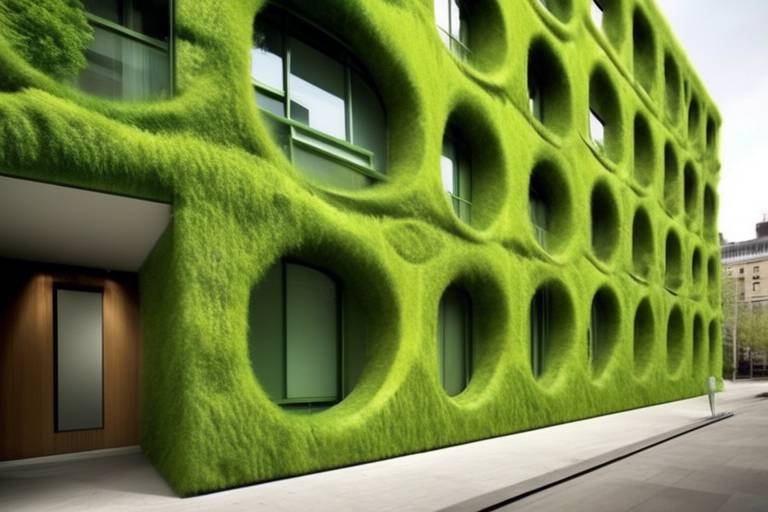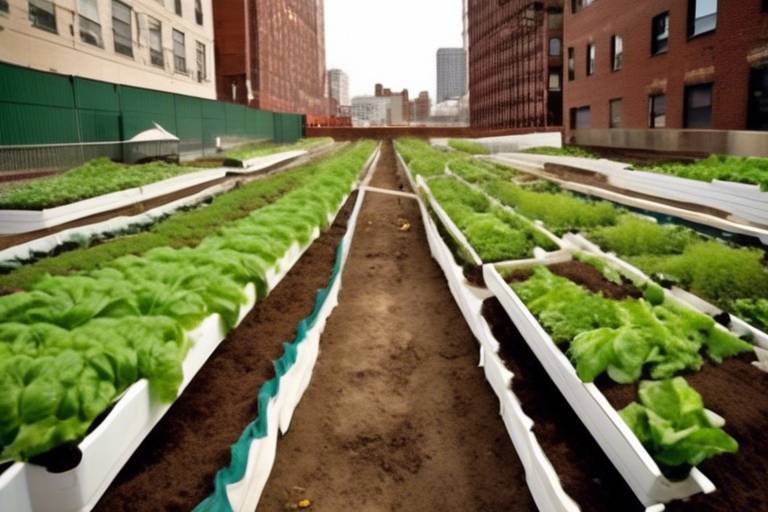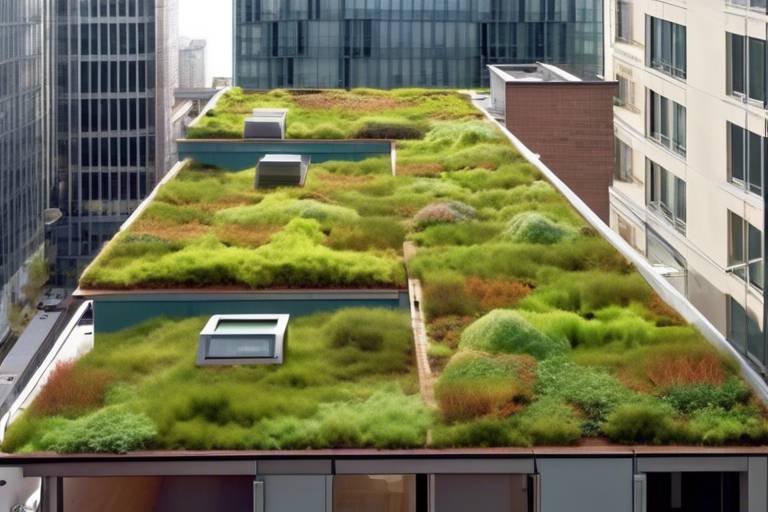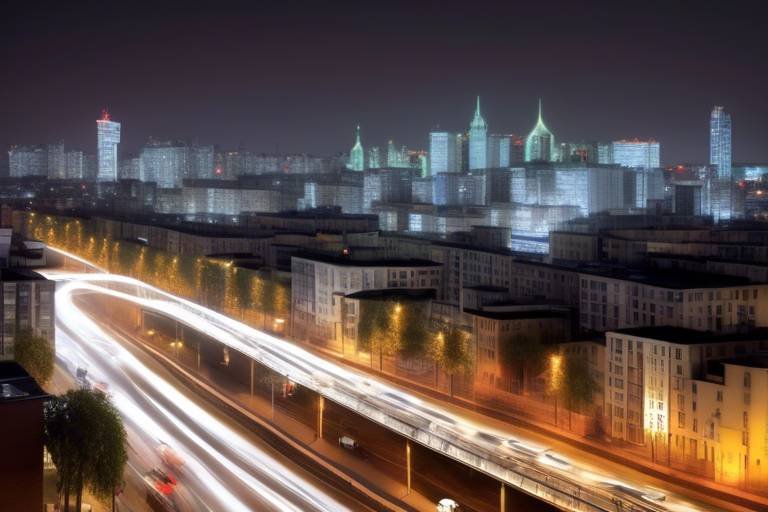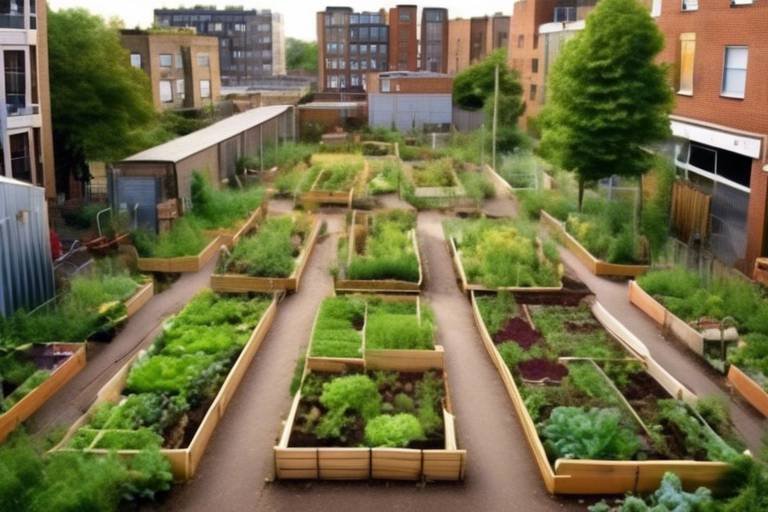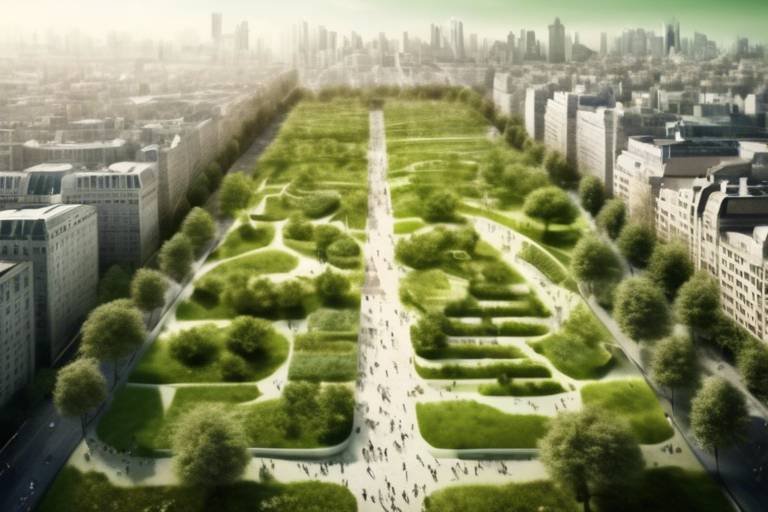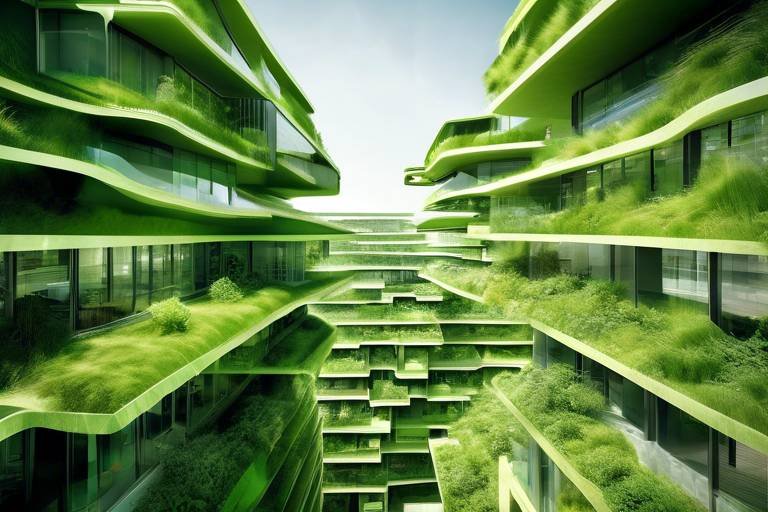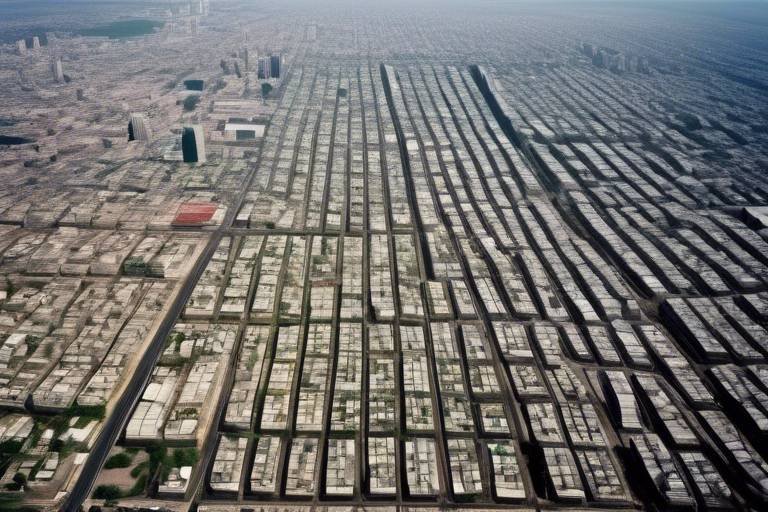The Importance of Green Urban Architecture
In an age where urbanization is skyrocketing, the need for green urban architecture has never been more pressing. Imagine a city where buildings breathe, parks flourish, and the air is fresh enough to fill your lungs with peace instead of pollution. This is not just a dream; it’s a necessity for our future. Green urban architecture plays a pivotal role in promoting sustainability and enhancing the quality of urban living. It’s about creating spaces that are not only functional but also harmonious with nature.
As cities expand, they often become concrete jungles that absorb heat and emit greenhouse gases. However, through innovative design principles, we can transform these urban landscapes into vibrant ecosystems. Think of green architecture as the urban equivalent of a well-tended garden—it requires planning, care, and a commitment to sustainability. By integrating natural elements into our cities, we can mitigate the environmental impacts associated with urban growth.
Moreover, green urban architecture is not just about aesthetics; it’s a holistic approach that encompasses social, economic, and environmental benefits. For example, by incorporating green roofs and walls, cities can reduce energy consumption and improve air quality. These features not only provide insulation but also create habitats for urban wildlife, thus enhancing biodiversity. The result? Healthier living environments that promote well-being and foster community connections.
In essence, the importance of green urban architecture lies in its ability to redefine the relationship between people and their environment. It encourages us to rethink how we design our cities, prioritizing sustainability and resilience. As we delve deeper into the principles and practices that shape modern green architecture, we will discover that the benefits extend far beyond the buildings themselves—they ripple through the entire urban ecosystem.
Green architecture offers numerous advantages, including reduced energy consumption, improved air quality, and enhanced urban biodiversity. These benefits contribute to healthier living environments and promote sustainability within urban settings.
Understanding the fundamental principles of green urban design is essential for creating sustainable cities. This section discusses concepts such as energy efficiency, water conservation, and the integration of natural elements into urban landscapes.
Implementing energy-efficient strategies is crucial in green urban architecture. This includes the use of renewable energy sources, smart building technologies, and passive design techniques that minimize energy consumption.
Incorporating renewable energy sources like solar panels and wind turbines can significantly reduce a building's carbon footprint. This approach not only benefits the environment but also lowers operational costs for urban developments.
Smart building technologies enhance energy efficiency through automation and real-time monitoring. These innovations optimize resource use, improve occupant comfort, and contribute to the overall sustainability of urban architecture.
Water conservation is a vital aspect of green urban architecture. Techniques such as rainwater harvesting, greywater recycling, and permeable surfaces help manage water resources effectively and reduce urban runoff.
The use of innovative green building materials is essential for sustainable construction. This section explores eco-friendly alternatives, including recycled materials, low-VOC paints, and sustainable timber, that contribute to healthier buildings.
Utilizing recycled and upcycled materials reduces waste and minimizes the environmental impact of construction. This practice supports a circular economy while providing unique aesthetic qualities to urban architecture.
Sustainable timber options, such as certified wood, promote responsible forestry practices. These materials offer durability and aesthetic appeal while ensuring that urban developments align with environmental conservation efforts.
Q: What is green urban architecture?
A: Green urban architecture refers to the design and construction of buildings and urban spaces that prioritize sustainability, energy efficiency, and the integration of natural elements.
Q: How does green architecture benefit the environment?
A: Green architecture reduces energy consumption, improves air quality, enhances biodiversity, and promotes sustainable resource management, contributing to healthier urban environments.
Q: What are some examples of green building materials?
A: Examples include recycled materials, low-VOC paints, sustainable timber, and materials that promote energy efficiency.
Q: How can cities implement green urban design?
A: Cities can implement green urban design by incorporating energy-efficient technologies, promoting green spaces, and utilizing sustainable materials in construction.

Benefits of Green Architecture
This article explores the significance of green urban architecture in promoting sustainability, enhancing urban living, and mitigating environmental impacts. It highlights various design principles, benefits, and innovative practices shaping modern cities.
Green architecture offers a plethora of advantages that extend beyond just aesthetics; it fundamentally transforms our urban spaces into healthier, more sustainable environments. One of the most significant benefits is the reduction of energy consumption. Buildings designed with green principles often utilize natural light and ventilation, which decreases reliance on artificial lighting and air conditioning. Imagine walking into a building that feels naturally cool during summer without blasting the AC—this is the power of energy-efficient design!
Another critical advantage is the improvement of air quality. Green buildings often incorporate materials that are less harmful to the environment and human health. By using low-VOC (volatile organic compounds) paints and finishes, the indoor air quality is significantly enhanced, which is especially beneficial for individuals with allergies or respiratory conditions. Furthermore, these buildings frequently feature green roofs and walls, which not only beautify the urban landscape but also filter pollutants and provide oxygen, creating a mini-ecosystem right in the heart of the city.
In addition to these benefits, green architecture promotes urban biodiversity. By integrating natural elements into urban designs—such as parks, gardens, and green corridors—these spaces become habitats for various species, contributing to a richer urban ecosystem. This is akin to creating an oasis in a desert of concrete, where both flora and fauna can thrive amidst the hustle and bustle of city life.
Moreover, the economic advantages cannot be overlooked. Green buildings often lead to lower operational costs due to their energy-efficient designs. Over time, the savings on utility bills can be substantial, making these buildings not just environmentally friendly but also financially savvy. According to a recent study, green buildings can save up to 30% on energy costs compared to traditional buildings. This is a win-win situation for both developers and occupants!
In summary, the benefits of green architecture are multi-faceted, encompassing not just environmental sustainability but also economic viability and improved quality of life. As cities continue to grow and evolve, embracing green architecture is not just an option; it's a necessity for a healthier, more sustainable future.
- What is green architecture? Green architecture refers to the design and construction of buildings that are environmentally responsible and resource-efficient throughout their life cycle.
- How does green architecture benefit the environment? It reduces energy consumption, improves air quality, and enhances urban biodiversity, contributing to a healthier ecosystem.
- Are green buildings more expensive to build? While the initial costs may be higher, the long-term savings on energy and maintenance often outweigh these costs.
- What materials are commonly used in green architecture? Common materials include recycled materials, low-VOC paints, and sustainable timber.

Key Principles of Green Urban Design
When it comes to crafting cities that are not just livable but also sustainable, green urban design stands at the forefront. It's not merely about putting up buildings; it's about creating environments that harmonize with nature and enhance the quality of life for all inhabitants. One of the key principles is energy efficiency. Imagine a city where buildings are designed to use less energy, not just through advanced technology but also through smart architectural choices. This means incorporating features like natural ventilation and insulation that work with the climate rather than against it.
Another essential principle is water conservation. Did you know that urban areas often face significant water management challenges? By implementing techniques such as rainwater harvesting and greywater recycling, cities can significantly reduce their water footprint. These systems not only conserve water but also help manage stormwater runoff, which is a major contributor to urban flooding. Imagine walking through a neighborhood where every drop of rain is harnessed and reused—now that's a vision of a sustainable future!
Moreover, the integration of natural elements into urban landscapes plays a pivotal role. Think parks, green roofs, and vertical gardens. These features not only beautify the city but also improve air quality and provide habitats for wildlife. In fact, studies have shown that urban greenery can lower temperatures and reduce the urban heat island effect, making cities more comfortable during sweltering summers. It's like giving the city a breath of fresh air!
To illustrate the impact of these principles, consider the following table that outlines how each principle contributes to sustainability:
| Principle | Impact on Sustainability |
|---|---|
| Energy Efficiency | Reduces energy consumption and greenhouse gas emissions. |
| Water Conservation | Minimizes water waste and enhances water management. |
| Integration of Natural Elements | Improves air quality and supports biodiversity. |
In summary, the key principles of green urban design are not just theoretical concepts; they are actionable strategies that can transform our cities into sustainable havens. By focusing on energy efficiency, water conservation, and the integration of natural elements, we can create urban spaces that are not only functional but also resilient and environmentally friendly. So, the next time you step into a city, take a moment to appreciate the design choices that contribute to a greener future!
- What is green urban design? Green urban design focuses on creating sustainable, environmentally friendly urban spaces that enhance the quality of life.
- Why is energy efficiency important? Energy efficiency reduces energy consumption, lowers costs, and minimizes environmental impact.
- How can water conservation be achieved in cities? Techniques such as rainwater harvesting and greywater recycling can significantly reduce water waste.
- What role do natural elements play in urban design? Natural elements improve air quality, provide habitats for wildlife, and enhance the aesthetic appeal of urban areas.

Energy Efficiency Strategies
In the quest for sustainable urban living, energy efficiency stands out as a cornerstone of green urban architecture. Implementing effective energy efficiency strategies not only reduces the overall energy consumption of buildings but also significantly lowers greenhouse gas emissions. Imagine living in a city where your home not only provides comfort but also contributes to a healthier planet. This is the vision that energy-efficient designs aim to achieve.
One of the most impactful strategies is the integration of renewable energy sources. By harnessing the power of the sun and wind, urban developments can drastically cut down on their reliance on fossil fuels. For instance, solar panels installed on rooftops can generate clean electricity, while wind turbines can capture energy from natural breezes. This shift not only benefits the environment but also provides long-term savings on energy bills for residents. The table below illustrates the potential energy savings from various renewable sources:
| Renewable Energy Source | Estimated Annual Savings (%) |
|---|---|
| Solar Energy | 30-50 |
| Wind Energy | 20-40 |
| Geothermal Energy | 25-50 |
Another vital component of energy efficiency is the adoption of smart building technologies. These innovations allow for real-time monitoring and automation of energy use, ensuring that resources are utilized optimally. Imagine your home adjusting its heating and cooling systems based on your presence or the time of day, automatically lowering energy consumption when you're not around. This level of automation not only enhances occupant comfort but also contributes to the overall sustainability of urban architecture.
Moreover, employing passive design techniques can significantly minimize energy consumption without the need for complex technology. This approach focuses on utilizing natural resources such as sunlight and wind to maintain comfortable indoor temperatures. For example, strategically placed windows can facilitate natural ventilation, reducing the need for air conditioning. Additionally, thermal mass materials can store heat during the day and release it at night, further enhancing energy efficiency.
In summary, the integration of renewable energy sources, smart building technologies, and passive design techniques forms a robust framework for energy efficiency in urban architecture. By embracing these strategies, we can create cities that not only meet the needs of their inhabitants but also protect our planet for future generations. This is not just about building structures; it's about constructing a sustainable future.
- What are the main benefits of energy-efficient buildings? Energy-efficient buildings reduce energy consumption, lower utility bills, and contribute to a healthier environment by decreasing greenhouse gas emissions.
- How can I make my home more energy-efficient? You can improve your home's energy efficiency by using renewable energy sources, upgrading insulation, installing energy-efficient windows, and utilizing smart home technologies.
- What is passive design? Passive design refers to architectural strategies that utilize natural resources for heating, cooling, and lighting, reducing the need for mechanical systems.

Renewable Energy Integration
Integrating renewable energy sources into urban architecture is a game-changer for sustainable development. Imagine a city where buildings not only consume energy but also generate it. This is not just a dream; it’s becoming a reality through innovative designs that harness the power of the sun, wind, and even geothermal energy. By implementing renewable energy systems, cities can drastically reduce their carbon footprints while promoting a cleaner, healthier environment.
One of the most popular forms of renewable energy integration is the use of solar panels. These panels can be installed on rooftops, integrated into building facades, or even used as part of shading structures. They convert sunlight into electricity, providing a sustainable energy source that can power everything from lighting to HVAC systems. In fact, studies show that buildings equipped with solar panels can reduce their energy bills by as much as 50%, making them not only environmentally friendly but also economically viable.
Another promising technology is the incorporation of wind turbines in urban settings. While it may sound unconventional, small-scale wind turbines can effectively harness wind energy, especially in high-rise buildings where wind currents are stronger. When combined with solar energy systems, these turbines provide a complementary energy source, ensuring that buildings remain powered even during periods of low sunlight. This synergy between solar and wind energy can lead to significant energy independence for urban developments.
Moreover, integrating geothermal energy systems can further enhance the sustainability of urban architecture. Geothermal systems utilize the constant temperature of the earth to regulate heating and cooling within buildings. This method is particularly effective in reducing reliance on conventional heating systems, leading to lower energy consumption and a reduced environmental impact.
To illustrate the potential benefits of renewable energy integration, consider the following table that highlights the advantages of different renewable energy sources:
| Energy Source | Advantages | Typical Applications |
|---|---|---|
| Solar Energy | Reduces electricity bills, low maintenance, scalable | Rooftop installations, building-integrated photovoltaics |
| Wind Energy | Generates clean energy, small footprint, complements solar | Small turbines on rooftops or open areas |
| Geothermal Energy | Highly efficient, low operating costs, stable energy source | Heating and cooling systems for buildings |
In conclusion, the integration of renewable energy sources into urban architecture is not just a trend; it’s a necessity for creating sustainable cities. By embracing solar, wind, and geothermal energy, urban planners and architects can pave the way for a future where cities thrive without compromising the health of our planet. The potential for innovation in this field is immense, and as technology advances, we can expect to see even more creative solutions that will redefine urban living.
- What are the main benefits of renewable energy integration in urban architecture?
Renewable energy integration helps reduce energy costs, lowers carbon emissions, and promotes energy independence. - Can all buildings utilize renewable energy sources?
While most buildings can benefit from renewable sources, the effectiveness varies based on location, design, and available resources. - How do solar panels work?
Solar panels convert sunlight into electricity using photovoltaic cells, which generate direct current (DC) that is then converted to alternating current (AC) for use in buildings. - Are wind turbines effective in urban areas?
Yes, small-scale wind turbines can be effective in urban areas, especially in taller buildings where wind speeds are higher.

Smart Building Technologies
In the ever-evolving landscape of urban architecture, are paving the way for a more sustainable and efficient future. Imagine a world where your home or office knows your preferences, adjusts its temperature automatically, and minimizes energy waste without you lifting a finger. Sounds like something out of a sci-fi movie, right? But this is the reality that smart technologies are bringing into our cities. These innovations not only enhance comfort but also play a crucial role in promoting energy efficiency and sustainability.
At the heart of smart building technologies is the concept of automation. Through a network of sensors and devices, buildings can monitor and adjust their systems in real-time. For example, lighting systems can automatically dim or turn off when natural light is sufficient, while heating and cooling systems can be optimized based on occupancy patterns. This level of automation significantly reduces energy consumption, ultimately leading to lower utility bills and a smaller carbon footprint.
Moreover, smart buildings can integrate with renewable energy sources, such as solar panels. By utilizing real-time data, these buildings can determine the best times to draw energy from the grid or rely on their solar power, maximizing efficiency. The integration of smart meters allows occupants to track their energy usage, encouraging more conscious consumption habits. With this information at their fingertips, residents can adjust their behaviors, further enhancing the building's sustainability.
One of the most exciting aspects of smart building technologies is their ability to improve occupant comfort. Imagine arriving home after a long day, and your house has already adjusted the temperature to your preferred setting. Smart thermostats, which learn your habits and preferences, make this possible. Additionally, smart lighting systems can create the perfect ambiance for any occasion, enhancing not just comfort but also well-being.
As cities continue to grow, the need for efficient resource management becomes increasingly vital. Smart building technologies contribute significantly to this effort by optimizing water usage as well. For instance, smart irrigation systems can monitor weather conditions and soil moisture levels, ensuring that landscapes are watered only when necessary. This not only conserves water but also promotes healthier green spaces in urban areas.
To illustrate the impact of smart technologies, consider the following table that highlights some key benefits:
| Benefit | Description |
|---|---|
| Energy Efficiency | Reduces energy consumption through automation and real-time monitoring. |
| Cost Savings | Lowers utility bills by optimizing energy use and integrating renewable sources. |
| Enhanced Comfort | Improves occupant experience with personalized settings for temperature and lighting. |
| Resource Management | Optimizes water usage and reduces waste through smart irrigation and monitoring systems. |
As we look towards the future, the implementation of smart building technologies is not just a trend; it is a necessity for creating sustainable urban environments. The integration of these technologies will not only transform how we interact with our spaces but will also play a pivotal role in combating climate change and promoting a healthier planet. So, the next time you hear about smart buildings, remember that they are not merely structures; they are intelligent systems designed to enhance our lives while being kind to the Earth.
- What are smart building technologies?
Smart building technologies refer to automated systems and devices that monitor and control building operations, such as energy use, lighting, heating, and water management, to enhance efficiency and comfort. - How do smart buildings save energy?
Smart buildings save energy by utilizing sensors and automation to optimize resource use, adjusting systems based on real-time data, and integrating renewable energy sources. - Are smart buildings more expensive to build?
While the initial investment in smart technologies may be higher, the long-term savings on utility bills and maintenance often outweigh these costs, making them a financially viable option. - Can smart building technologies improve occupant comfort?
Yes, smart technologies can create personalized environments by adjusting lighting, temperature, and other settings based on individual preferences.

Water Conservation Techniques
Water conservation is not just a trend; it’s a necessity in today’s rapidly urbanizing world. As cities expand, the demand for water increases, leading to potential shortages and environmental degradation. Green urban architecture embraces innovative water conservation techniques that not only help to manage this precious resource but also enhance the overall sustainability of urban living.
One of the most effective methods for conserving water in urban environments is rainwater harvesting. This technique involves collecting and storing rainwater from roofs and other surfaces, which can then be used for irrigation, flushing toilets, or even washing clothes. Imagine a city where every drop of rain is captured and utilized; this not only reduces the demand on municipal water systems but also decreases runoff that can lead to flooding and pollution in local waterways.
Another important strategy is the implementation of greywater recycling. Greywater refers to the relatively clean wastewater generated from sinks, showers, and washing machines, excluding toilet waste. By treating and reusing this water for irrigation or toilet flushing, urban areas can significantly reduce their overall water consumption. This practice not only conserves water but also minimizes the energy required for water treatment and distribution. In fact, it’s estimated that households can recycle up to 50-80% of their wastewater, which is a game-changer for water sustainability.
Furthermore, the use of permeable surfaces in urban landscaping is gaining traction. Traditional concrete and asphalt surfaces prevent water from soaking into the ground, leading to increased runoff and potential flooding. In contrast, permeable pavements allow rainwater to filter through, recharging groundwater supplies and reducing surface runoff. This not only aids in water conservation but also helps to mitigate the heat island effect often experienced in urban areas.
To illustrate the impact of these techniques, consider the following table that summarizes the benefits of different water conservation methods:
| Technique | Benefits |
|---|---|
| Rainwater Harvesting | Reduces demand on municipal water supply, minimizes runoff, and provides an alternative water source. |
| Greywater Recycling | Conserves potable water, reduces wastewater treatment costs, and lowers overall water consumption. |
| Permeable Surfaces | Enhances groundwater recharge, reduces flooding risk, and helps mitigate urban heat. |
In conclusion, adopting these water conservation techniques in green urban architecture is essential for creating sustainable cities. By implementing rainwater harvesting, greywater recycling, and permeable surfaces, urban areas can significantly reduce their water footprint while enhancing the quality of life for their residents. As we continue to face the challenges of climate change and urbanization, these innovative practices will play a crucial role in ensuring that our cities remain vibrant, resilient, and sustainable for generations to come.
- What is rainwater harvesting? Rainwater harvesting is the process of collecting and storing rainwater for reuse, typically for irrigation, flushing toilets, or other non-potable uses.
- How does greywater recycling work? Greywater recycling involves treating wastewater from sinks, showers, and washing machines so it can be reused for irrigation or toilet flushing.
- What are permeable surfaces? Permeable surfaces are materials that allow water to pass through, reducing runoff and promoting groundwater recharge.

Innovative Green Building Materials
This article explores the significance of green urban architecture in promoting sustainability, enhancing urban living, and mitigating environmental impacts. It highlights various design principles, benefits, and innovative practices shaping modern cities.
Green architecture offers numerous advantages, including reduced energy consumption, improved air quality, and enhanced urban biodiversity. These benefits contribute to healthier living environments and promote sustainability within urban settings.
Understanding the fundamental principles of green urban design is essential for creating sustainable cities. This section discusses concepts such as energy efficiency, water conservation, and the integration of natural elements into urban landscapes.
Implementing energy-efficient strategies is crucial in green urban architecture. This includes the use of renewable energy sources, smart building technologies, and passive design techniques that minimize energy consumption.
Incorporating renewable energy sources like solar panels and wind turbines can significantly reduce a building's carbon footprint. This approach not only benefits the environment but also lowers operational costs for urban developments.
Smart building technologies enhance energy efficiency through automation and real-time monitoring. These innovations optimize resource use, improve occupant comfort, and contribute to the overall sustainability of urban architecture.
Water conservation is a vital aspect of green urban architecture. Techniques such as rainwater harvesting, greywater recycling, and permeable surfaces help manage water resources effectively and reduce urban runoff.
The use of innovative green building materials is essential for sustainable construction. These materials not only minimize environmental impact but also enhance the overall aesthetic and functionality of urban structures. For instance, recycled materials play a pivotal role in reducing waste. By repurposing materials that would otherwise end up in landfills, we contribute to a more sustainable future. Imagine transforming discarded glass into beautiful tiles or old bricks into stunning facades; this practice not only reduces waste but also adds a unique character to buildings.
Another exciting development in green architecture is the use of low-VOC paints. These paints significantly improve indoor air quality by minimizing the release of volatile organic compounds, which can be harmful to both health and the environment. Choosing low-VOC options is akin to opting for a breath of fresh air in your home, ensuring that the spaces we inhabit are as healthy as they are beautiful.
Additionally, sustainable timber options, such as certified wood, are gaining traction in the construction industry. These materials are sourced from responsibly managed forests, ensuring that we are not depleting our natural resources. Not only do they provide durability and aesthetic appeal, but they also align with environmental conservation efforts. Think of sustainable timber as the backbone of green architecture, supporting structures while maintaining a commitment to the planet.
To illustrate the impact of these materials, consider the following table showcasing the benefits of various innovative green building materials:
| Material | Benefits |
|---|---|
| Recycled Materials | Reduces waste, unique aesthetics |
| Low-VOC Paints | Improves indoor air quality, health-friendly |
| Sustainable Timber | Durable, eco-friendly, supports responsible forestry |
In conclusion, the integration of these innovative green building materials not only enhances the sustainability of urban architecture but also enriches the quality of life for its inhabitants. By choosing materials that are both environmentally friendly and aesthetically pleasing, we pave the way for a greener, more sustainable future.
- What are green building materials?
Green building materials are environmentally friendly products that are used in construction to reduce the overall impact on the environment.
- How do recycled materials benefit urban architecture?
Recycled materials help to minimize waste, reduce resource consumption, and often provide unique aesthetic qualities to buildings.
- What is low-VOC paint?
Low-VOC paint contains fewer volatile organic compounds, making it a healthier choice for indoor air quality.
- Why is sustainable timber important?
Sustainable timber promotes responsible forestry practices and ensures that wood is sourced from managed forests, reducing deforestation.

Recycled and Upcycled Materials
When it comes to sustainable construction, are game changers. Imagine walking through a building and knowing that the walls were once part of a dismantled factory or that the flooring was salvaged from an old ship. This isn't just a trend; it's a movement towards a more sustainable future. By utilizing materials that have already served a purpose, we not only reduce waste but also breathe new life into what would otherwise be discarded.
Recycled materials are those that have been processed to create new products, while upcycled materials are repurposed into something of greater value or quality. Both practices play a crucial role in minimizing the carbon footprint of construction projects. For instance, using recycled steel can save up to 74% of the energy required to produce new steel. This not only conserves energy but also reduces greenhouse gas emissions significantly.
Furthermore, upcycled materials often bring a unique aesthetic to urban architecture. They tell a story, adding character and charm to a space. Think about reclaimed wood beams or vintage bricks that add a rustic feel to modern designs. This blend of old and new creates a visual narrative that resonates with many people, making buildings feel more inviting and less sterile.
Here’s a quick look at some common recycled and upcycled materials used in green architecture:
| Material Type | Description | Benefits |
|---|---|---|
| Recycled Steel | Steel that has been melted down and reformed. | Energy-efficient and strong; reduces resource extraction. |
| Reclaimed Wood | Wood salvaged from old buildings or structures. | Durable, unique aesthetics; reduces deforestation. |
| Recycled Glass | Glass that has been crushed and repurposed. | Versatile, can be used in countertops or tiles; reduces landfill waste. |
| Upcycled Fabrics | Textiles repurposed from old clothing or materials. | Creative and sustainable; reduces textile waste. |
Incorporating these materials into urban architecture not only supports a circular economy but also encourages creativity among architects and builders. The challenge lies in sourcing these materials and ensuring they meet safety and quality standards. However, the rewards far outweigh the challenges, as they contribute to a healthier environment and foster a sense of community by preserving local history.
- What are recycled materials? Recycled materials are those that have been processed to create new products, reducing the need for new raw materials.
- What is upcycling? Upcycling is the process of repurposing materials into new products of higher quality or value.
- Why are recycled and upcycled materials important? They help reduce waste, conserve resources, and lower the environmental impact of construction.
- Can I use recycled materials in my home renovation? Absolutely! Many homeowners choose recycled materials for aesthetic and environmental reasons.

Sustainable Timber Options
When it comes to constructing environmentally friendly buildings, play a pivotal role. These materials not only contribute to reducing the carbon footprint of urban architecture but also promote responsible forestry practices. Imagine walking through a forest where trees are harvested in a way that ensures the ecosystem remains intact—this is the essence of sustainable timber. By choosing timber sourced from responsibly managed forests, we are not just building structures; we are nurturing our planet.
One of the key benefits of using sustainable timber is its renewable nature. Unlike concrete or steel, which have significant environmental impacts during production, timber can be replenished through careful management. For instance, certified wood, such as that bearing the FSC (Forest Stewardship Council) label, ensures that the timber is sourced from forests that are managed sustainably. This means that for every tree cut down, another is planted, maintaining the forest's health and biodiversity.
Moreover, sustainable timber options provide remarkable durability and aesthetic appeal. From the warm tones of cedar to the rich grains of oak, timber adds a unique character to any design. Architects and builders are increasingly recognizing that using materials like reclaimed wood not only enhances the beauty of a structure but also tells a story of sustainability. Reclaimed wood, which is salvaged from old buildings, reduces waste and gives a second life to materials that would otherwise end up in landfills.
In addition to aesthetic and environmental benefits, sustainable timber also aligns with energy efficiency goals. Wood has natural insulating properties, which can help reduce heating and cooling costs in buildings. This means that not only are we making a choice that benefits the environment, but we are also creating spaces that are cost-effective to maintain. The integration of sustainable timber options in design can lead to significant long-term savings, making it a wise investment for urban developers.
To summarize, the adoption of sustainable timber options is crucial for the future of green urban architecture. It embodies the principles of sustainability, enhances the beauty of our cities, and supports a healthier planet. As we continue to innovate in construction practices, let’s make a conscious effort to choose materials that reflect our commitment to the environment. The next time you consider building or renovating, think about the impact of your material choices—because every decision counts in creating a sustainable future.
- What is sustainable timber? Sustainable timber is wood sourced from forests that are managed in a way that preserves biodiversity, respects indigenous rights, and ensures that the forest can regenerate.
- How can I identify sustainable timber? Look for certifications such as FSC (Forest Stewardship Council) or PEFC (Programme for the Endorsement of Forest Certification) that indicate responsible sourcing.
- What are the benefits of using sustainable timber in construction? Benefits include reduced environmental impact, enhanced aesthetic appeal, natural insulation properties, and support for responsible forestry practices.
- Can reclaimed wood be considered sustainable? Yes, reclaimed wood is a sustainable option as it repurposes existing materials, reducing waste and the need for new timber production.
Frequently Asked Questions
- What is green urban architecture?
Green urban architecture refers to the design and construction of buildings and spaces that prioritize sustainability and environmental health. It incorporates principles like energy efficiency, water conservation, and the use of eco-friendly materials to create urban environments that are not only livable but also beneficial for the planet.
- What are the benefits of green architecture?
Green architecture offers numerous benefits, including reduced energy consumption, improved air quality, and enhanced urban biodiversity. These advantages contribute to healthier living environments, help mitigate climate change, and promote overall sustainability within urban settings.
- How does energy efficiency play a role in green urban design?
Energy efficiency is a cornerstone of green urban design. It involves implementing strategies such as using renewable energy sources, smart building technologies, and passive design techniques. These methods help minimize energy consumption, reduce costs, and lower a building's carbon footprint.
- What are some examples of renewable energy integration in urban architecture?
Examples of renewable energy integration include the installation of solar panels, wind turbines, and geothermal heating systems. These technologies harness natural energy sources, significantly reducing a building's reliance on fossil fuels and lowering operational costs.
- What is the significance of water conservation in green architecture?
Water conservation is crucial in green architecture as it helps manage water resources effectively. Techniques like rainwater harvesting, greywater recycling, and the use of permeable surfaces reduce urban runoff and ensure that water is used sustainably, which is vital in urban areas facing water scarcity.
- What types of materials are considered eco-friendly in construction?
Eco-friendly materials include recycled and upcycled materials, low-VOC (volatile organic compounds) paints, and sustainable timber options. These materials not only reduce waste but also promote responsible sourcing and contribute to healthier indoor environments.
- How do recycled materials contribute to sustainable construction?
Recycled materials help reduce the amount of waste generated during construction and minimize the environmental impact. By reusing materials, we support a circular economy, which is essential for sustainability and resource conservation in urban development.
- What are sustainable timber options, and why are they important?
Sustainable timber options, such as certified wood, ensure that forestry practices are responsible and environmentally friendly. These materials provide durability and aesthetic appeal while helping to preserve forests and promote biodiversity, making them a vital choice for green urban architecture.

